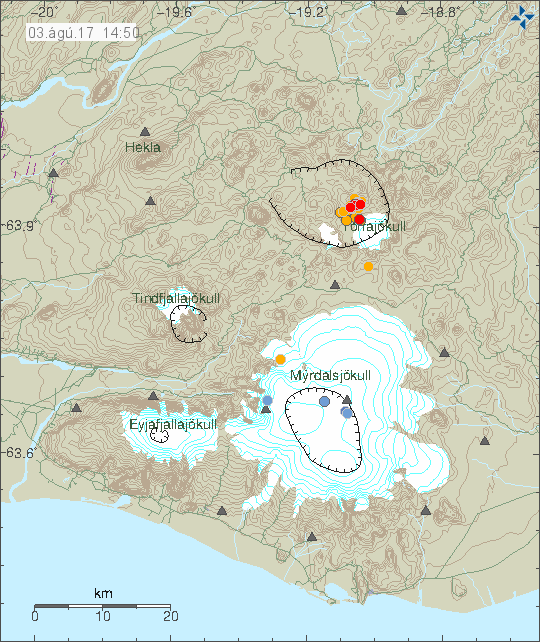A sharp earthquake swarm was detected in the sub-glacial Torfajökull volcano early this morning. The earthquake swarm is the latest in a series of powerful seismic activity in the past week, following on the heels of sharp seismic activity in two of Iceland's most powerful volcanoes, Katla and Bárðarbunga, and an intense earthquake swarm on Reykjanes peninsula.
Read more: Powerful earthquake swarm in Bárðarbunga volcano, 4.5 magnitude quake near Holuhraun lava field

The swarm began at 23 minutes past 9 this morning. The epicenter of the quakes has been in the caldera of the Torfajökull volcano, with more than two dozen small quakes being detected. According to the Icelandic Meteorological Office none of the quakes were particularly large, with most quakes measuring between 1 and 2 on the Richter scale. What makes the quakes noteworthy, however, is that while solitary quakes are common outside the most active areas, the major volcanic systems and fracture zones, earthquake swarms are less common outside these areas.
The Torfajökull area is one of the most geologically active areas in Iceland. The Torfajökull volcano, hidden beneath the glacier of the same name, is an independent volcanic system, separate from the Katla and Eyjafjallajökull systems to its south. The Torfajökull volcano is the largest caldera in Iceland, and the area is the second most powerful geothermal area in Iceland. The volcano is considered active, although it erupts only one or twice each millennia. The last eruption in Torfajökull took place in 1477. A second eruption took place in 872.
Read more: Why the constant earthquakes? Iceland is slowly being torn apart
A seismologist at the Icelandic Meteorological Office who spoke to the local newspaper Morgunblaðið said that there were no signs of growing volcanic activity in Torfajökull. It isn't unknown to see quakes here, there have been swarms in Torfajökull, for example last winter.
The other volcanic systems which have been active in the past week all seem to have calmed down for the time being.
A sharp earthquake swarm was detected in the sub-glacial Torfajökull volcano early this morning. The earthquake swarm is the latest in a series of powerful seismic activity in the past week, following on the heels of sharp seismic activity in two of Iceland's most powerful volcanoes, Katla and Bárðarbunga, and an intense earthquake swarm on Reykjanes peninsula.
Read more: Powerful earthquake swarm in Bárðarbunga volcano, 4.5 magnitude quake near Holuhraun lava field

The swarm began at 23 minutes past 9 this morning. The epicenter of the quakes has been in the caldera of the Torfajökull volcano, with more than two dozen small quakes being detected. According to the Icelandic Meteorological Office none of the quakes were particularly large, with most quakes measuring between 1 and 2 on the Richter scale. What makes the quakes noteworthy, however, is that while solitary quakes are common outside the most active areas, the major volcanic systems and fracture zones, earthquake swarms are less common outside these areas.
The Torfajökull area is one of the most geologically active areas in Iceland. The Torfajökull volcano, hidden beneath the glacier of the same name, is an independent volcanic system, separate from the Katla and Eyjafjallajökull systems to its south. The Torfajökull volcano is the largest caldera in Iceland, and the area is the second most powerful geothermal area in Iceland. The volcano is considered active, although it erupts only one or twice each millennia. The last eruption in Torfajökull took place in 1477. A second eruption took place in 872.
Read more: Why the constant earthquakes? Iceland is slowly being torn apart
A seismologist at the Icelandic Meteorological Office who spoke to the local newspaper Morgunblaðið said that there were no signs of growing volcanic activity in Torfajökull. It isn't unknown to see quakes here, there have been swarms in Torfajökull, for example last winter.
The other volcanic systems which have been active in the past week all seem to have calmed down for the time being.







